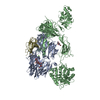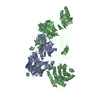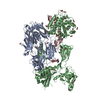+ Open data
Open data
- Basic information
Basic information
| Entry | Database: SASBDB / ID: SASDEM4 |
|---|---|
 Sample Sample | HrpG/HrpV/HrpJ gatekeeper complex from Erwinia amylovora
|
| Function / homology |  Function and homology information Function and homology information protein secretion by the type III secretion system / outer membrane / : / negative regulation of protein secretion / protein secretion by the type III secretion system / outer membrane / : / negative regulation of protein secretion /  cell surface cell surfaceSimilarity search - Function |
| Biological species |   Erwinia amylovora (strain CFBP1430) (bacteria) Erwinia amylovora (strain CFBP1430) (bacteria) |
 Citation Citation |  Journal: mBio / Year: 2018 Journal: mBio / Year: 2018Title: Migration of Type III Secretion System Transcriptional Regulators Links Gene Expression to Secretion. Authors: Spyridoula N Charova / Anastasia D Gazi / Efstratios Mylonas / Charalambos Pozidis / Blanca Sabarit / Dimitrios Anagnostou / Konstantina Psatha / Michalis Aivaliotis / Carmen R Beuzon / ...Authors: Spyridoula N Charova / Anastasia D Gazi / Efstratios Mylonas / Charalambos Pozidis / Blanca Sabarit / Dimitrios Anagnostou / Konstantina Psatha / Michalis Aivaliotis / Carmen R Beuzon / Nickolas J Panopoulos / Michael Kokkinidis /    Abstract: Many plant-pathogenic bacteria of considerable economic importance rely on type III secretion systems (T3SSs) of the Hrc-Hrp 1 family to subvert their plant hosts. T3SS gene expression is regulated ...Many plant-pathogenic bacteria of considerable economic importance rely on type III secretion systems (T3SSs) of the Hrc-Hrp 1 family to subvert their plant hosts. T3SS gene expression is regulated through the HrpG and HrpV proteins, while secretion is controlled by the gatekeeper HrpJ. A link between the two mechanisms was so far unknown. Here, we show that a mechanistic coupling exists between the expression and secretion cascades through the direct binding of the HrpG/HrpV heterodimer, acting as a T3SS chaperone, to HrpJ. The ternary complex is docked to the cytoplasmic side of the inner bacterial membrane and orchestrates intermediate substrate secretion, without affecting early substrate secretion. The anchoring of the ternary complex to the membranes potentially keeps HrpG/HrpV away from DNA. In their multiple roles as transcriptional regulators and gatekeeper chaperones, HrpV/HrpG provide along with HrpJ potentially attractive targets for antibacterial strategies. On the basis of scientific/economic importance, and are considered among the top 10 plant-pathogenic bacteria in molecular plant pathology. Both employ type III secretion systems (T3SSs) of the Hrc-Hrp 1 family to subvert their plant hosts. For Hrc-Hrp 1, no functional link was known between the key processes of T3SS gene expression and secretion. Here, we show that a mechanistic coupling exists between expression and secretion cascades, through formation of a ternary complex involving the T3SS proteins HrpG, HrpV, and HrpJ. Our results highlight the functional and structural properties of a hitherto-unknown complex which orchestrates intermediate T3SS substrate secretion and may lead to better pathogen control through novel targets for antibacterial strategies. |
 Contact author Contact author |
|
- Structure visualization
Structure visualization
| Structure viewer | Molecule:  Molmil Molmil Jmol/JSmol Jmol/JSmol |
|---|
- Downloads & links
Downloads & links
-Models
| Model #2378 |  Type: mix / Radius of dummy atoms: 1.90 A / Comment: CORAL model with reconstructed polypetide chain. / Chi-square value: 6.615184  Search similar-shape structures of this assembly by Omokage search (details) Search similar-shape structures of this assembly by Omokage search (details) |
|---|
- Sample
Sample
 Sample Sample | Name: HrpG/HrpV/HrpJ gatekeeper complex from Erwinia amylovora Specimen concentration: 1.5 mg/ml / Entity id: 1296 / 1297 / 1298 |
|---|---|
| Buffer | Name: 20mM Tris-Cl, pH 8.0, 100mM NaCl, 2mM DTT, 0.5mM EDTA / pH: 8 |
| Entity #1296 | Type: protein Description: Type III secretion protein HrpG  Type three secretion system Type three secretion systemFormula weight: 19.166 / Source: Erwinia amylovora (strain CFBP1430) / References: UniProt: D4HVP1 Sequence: MSYYHHHHHH DYDIPTTENL YFQGAMRSTE LQQWAQRWLD DVGTDQQLTV DDGVVWLQRR ADRFFALAEL TINASLDDEL LGRALQLSAP TLRYFGRDAA ALAQQGNSLI LALAIRQLEV NAVCQQLESL LNQRDVWQTM LQQPRRKAAT HGAVPLHSLA FLPRGNHG |
| Entity #1297 | Type: protein Description: Type III secretion protein HrpV  Type three secretion system Type three secretion systemFormula weight: 13.164 / Source: Erwinia amylovora (strain CFBP1430) / References: UniProt: D4HVP4 Sequence: MNNPCPQVTS LSALLSLLQL RQSCRWPVQQ GVELLALCGE RGRELMLNLQ PAFQPSGLYQ RLLSRRAQQL EIYDGCYLCL NHDRVLSCWR QLPESAMSDK QHIAQLFSLA GIHLAD |
| Entity #1298 | Type: protein Description: Hypersensitivity response secretion protein HrpJ Formula weight: 42.4 / Source: Erwinia amylovora (strain CFBP1430) / References: UniProt: D4HVM8 Sequence: MKIAPVLPGI QPPHPVAINA ADEAPAPTSV APSAAASASA RMPVSPLEDS MEEVSMTFAE HVERKSKALN QRRVVAQPGG RAQQHIERIE KLDELLKLLE HPQHARLETQ NQKMQTLLQH SASPGMDELL HAAGGDPARC DVLLRHTLLQ AQRTQNSELA TKAAQSLELL ...Sequence: MKIAPVLPGI QPPHPVAINA ADEAPAPTSV APSAAASASA RMPVSPLEDS MEEVSMTFAE HVERKSKALN QRRVVAQPGG RAQQHIERIE KLDELLKLLE HPQHARLETQ NQKMQTLLQH SASPGMDELL HAAGGDPARC DVLLRHTLLQ AQRTQNSELA TKAAQSLELL HKEKGAEVSA GLNTASAIAS FSTDPTQKQV MRQLYYQTIV HLQSGNAMLD ALLNSFGSAH FNQGLRTLQR ALADDIASRS SSIPRRALQK ILSSLQDASN ISQTLTASKT LLTRLAGKLP TINFTSLELT RRLLNLSGNG AYLRDLQNLS RDVAGQHPHH QVLFLSGLVP LVYHLPLGLW RDDKSKNRQM ALNLLRKVIS DYAGQEPRAS LTQPRTAL |
-Experimental information
| Beam | Instrument name: SOLEIL SWING  / City: Saint-Aubin / 国: France / City: Saint-Aubin / 国: France  / Type of source: X-ray synchrotron / Type of source: X-ray synchrotron Synchrotron / Wavelength: 0.1033 Å / Dist. spec. to detc.: 3.1 mm Synchrotron / Wavelength: 0.1033 Å / Dist. spec. to detc.: 3.1 mm | ||||||||||||||||||||
|---|---|---|---|---|---|---|---|---|---|---|---|---|---|---|---|---|---|---|---|---|---|
| Detector | Name: AVIEX PCCD170170 / Type: CCD | ||||||||||||||||||||
| Scan | Measurement date: Apr 3, 2016 / Storage temperature: 4 °C / Cell temperature: 15 °C / Exposure time: 0.5 sec. / Number of frames: 30 / Unit: 1/A /
| ||||||||||||||||||||
| Distance distribution function P(R) |
| ||||||||||||||||||||
| Result |
|
 Movie
Movie Controller
Controller


 SASDEM4
SASDEM4







